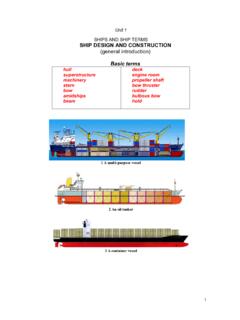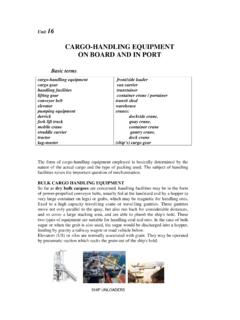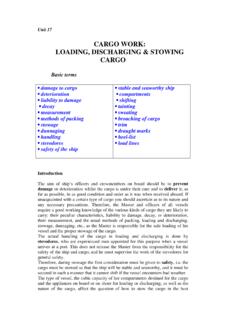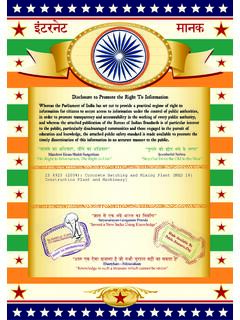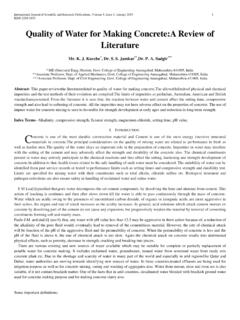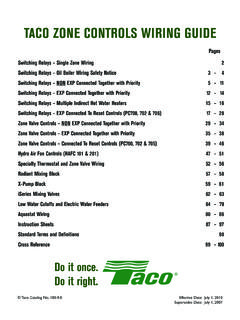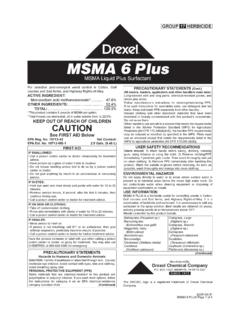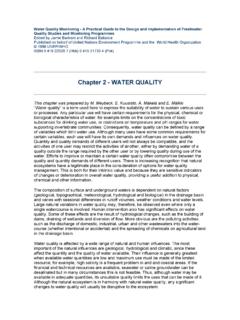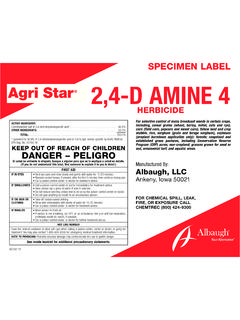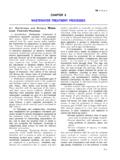Transcription of WATER COOLING SYSTEM - UNIRI
1 14 WATER COOLING SYSTEM An English language learning unit based on authentic materials from: (THE LEARNING RESOURCE FOR MARINE ENGINEERS) etc. How The Engine Is Cooled Although there is an abundance of free sea WATER available, marine diesel engines do not use it directly to keep the hottest parts of the engine cool. This is because of the corrosion which would be caused in the COOLING WATER spaces, and the salts which would be deposited on the COOLING surfaces interfering with the heat flow. Instead, the WATER circulated around the engine is fresh WATER ( or better still, distilled WATER ) which is then itself cooled using sea WATER . This fresh WATER is treated with chemicals to keep it slightly alkaline ( to prevent corrosion) and to prevent scale formation.
2 Of course, if distilled WATER , which some ships can make from sea WATER using evaporators, is used then there is a reduced risk of scale formation. Answer the following questions How The Engine Is Cooled are the hottest parts of the engine cooled? .. do we not use sea WATER for direct COOLING ? .. is used instead? .. is fresh WATER is treated with chemicals? .. is distilled WATER produced on bord? .. is the advantage uf using distilled WATER ? .. The COOLING WATER pump which may be engine driven or be a separate electrically driven pump pushes the WATER around the circuit. After passing through the engine, where it removes the heat from the cylinder liners, cylinder heads, exhaust valves and sometimes the turbochargers, it is cooled by seawater and then returns to the engine.
3 The temperature of the COOLING WATER is closely controlled using a three way control valve. If the WATER is allowed to get too cold then it will cause thermal shocking which may lead to component failure and will also allow WATER and acids to condense on the cylinder bores washing away the lubricating film and causing corrosion. If it gets too hot then it will not remove the heat effectively causing excessive wear and there is a greater danger of scale formation. For this reason the COOLING WATER outlet temperature is usually maintained at about 78-82 C. Because it is at a higher temperature than the COOLING WATER used for other purposes (known as the LT COOLING ), the WATER for COOLING the engine is known as the HT (High Temperature) COOLING WATER .
4 Fill in the gaps The COOLING WATER pump which may be _____ driven or be a separate _____ driven pump pushes the WATER around the _____ . After passing through the engine, where it _____ the heat from the cylinder liners, cylinder heads, _____ and sometimes the turbochargers, it is cooled by _____ and then returns to the engine. The temperature of the COOLING WATER is closely controlled using a _____ control valve. If the WATER is allowed to get too cold then it will cause thermal _____ which may lead to component _____ and will also allow WATER and acids to condense on the _____ washing away the lubricating film and causing _____ . If it gets too hot then it will not remove the heat effectively causing excessive wear and there is a greater danger of scale formation.
5 For this reason the COOLING WATER outlet temperature is usually maintained at about 78-82 C. Because it is at a higher temperature than the _____ used for other purposes (known as the _____ ), the WATER for COOLING the engine is known as the HT (_____ ) COOLING WATER . Supply the missing info: The COOLING WATER pump which may be .. or .. pushes the WATER around the circuit. After passing through the engine, where it .., cylinder heads, exhaust valves and sometimes the turbochargers, it is cooled by seawater and then .. The temperature of the COOLING WATER is closely controlled using .. If the WATER is allowed to get too cold then it will cause thermal shocking which may lead to .. and will also allow WATER and .. washing away the lubricating film and causing corrosion.
6 If it .. then it will not remove the heat effectively causing excessive wear and there is a greater danger of scale formation.. the COOLING WATER outlet temperature is usually maintained at about 78-82 C. Because it is at a higher temperature than the COOLING WATER used for other purposes (known as the LT COOLING ), the .. is known as the HT (High Temperature) COOLING WATER . There are two HT COOLING pumps fitted. These are centrifugal pumps which maintain the COOLING WATER circulating pressure at about 4 Bar. The temperature of the COOLING WATER is controlled automatically by a 3 way valve. If no COOLING is required (when the engine is stopped) then the valve allows WATER to circulate through the valve back to the pumps. If COOLING is required, then WATER is diverted to the Low Temperature (LT) SYSTEM and replaced with cool WATER from the LT SYSTEM .
7 The LT WATER is cooled using sea WATER in plate coolers. COOLING can be achieved by using a dedicated cooler or by mixing in some of the WATER from the LT COOLING circuit. The LT COOLING WATER is then cooled in the sea WATER coolers. The temperature is controlled using cascade control which monitors both the inlet and outlet temperatures from the engine. This allows a fast response to any change in temperature due to a change in engine load. The fresh WATER generator (or evaporator) uses the heat from the main engines in the COOLING WATER to produce fresh WATER from sea WATER . The pressure in the evaporator is below atmospheric ( a vacuum) so that the WATER boils at a lower temperature (about 65 C). On a large passenger vessel the evaporators can produce 500 tons/day.
8 This version is for a container ship and can produce 30 tons/day. To make up for any leaks in the SYSTEM there is a header tank, which automatically makes up any deficiency. Vents from the SYSTEM are also led to this header tank to allow for any expansion in the SYSTEM and to get rid of any air (if you are familiar with a domestic central heating SYSTEM then you will see the similarities). The header tank is relatively small, and usually placed high in the engine room. It is deliberately made to be manually replenished, and is fitted with a low level alarm. This is so that any major leak would be noticed immediately. Under normal conditions, the tank is checked once per watch, and if it needs topping up, then the amount logged. Underline the terms pertaining to COOLING WATER : To make up for any leaks in the SYSTEM there is a header tank, which automatically makes up any deficiency.
9 Vents from the SYSTEM are also led to this header tank to allow for any expansion in the SYSTEM and to get rid of any air. The header tank is relatively small, and usually placed high in the engine room. It is deliberately made to be manually replenished, and is fitted with a low level alarm. This is so that any major leak would be noticed immediately. Under normal conditions, the tank is checked once per watch, and if it needs topping up, then the amount logged. Supply the missing info: To make up for any leaks in the SYSTEM there is a header tank, which .. Vents from the SYSTEM are .. SYSTEM and to get rid of any air (if you are familiar .. then you will see the similarities). The header tank is relatively small, and usually placed.
10 It is deliberately made .. , and is fitted with a low level alarm. This is so that any major leak would .., the tank is checked once per watch, and if it needs topping up, then the amount logged. The SYSTEM will also contain a heater which is to keep the COOLING WATER hot when the engine is stopped, or to allow the temperature to be raised to a suitable level prior to starting. Some ships use a central COOLING SYSTEM , whereby the same COOLING WATER is circulated through the main engine(s) and the alternator engines. This SYSTEM has the advantage whereby the engines which are stopped are kept warm ready for immediate starting by the engines which are running. Complete the following sentences: The function of the heater is to.



